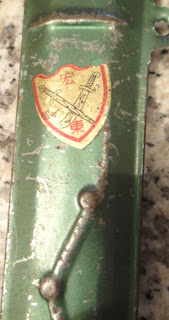 |
| The Playing Fields of Eton |
Sometimes an old document of no great importance gives us a glimpse into another world. Here is a list of demerits earned in 1878 by a student in boarding school named C. Boutelle. I can’t tell you his first name, or what school he attended, or how this report was used—speculation will have to suffice.
 |
| Demerits of C. Boutelle |
To save your eyes, I have transcribed this, adding a few comments along the way:
==============================================
Demerits of C. Boutelle
for the week ending Nov. 24 [1878]
All this in one week! C. Boutelle certainly kept busy!
15 Going away without Permission & not returning till next day
Here is a real offence, and I am surprised it was handled through the demerit system.
1 Running down stairs
1 Tardy at bell
1 Entering schoolroom with hat on
Aha! C. Boutelle was a guy.
1 Feet on Desk
Ditto!
4 Impertinent Reply
2 Disrespectful Language
Makes you wonder the difference between impertinent and disrespectful. I would have thought disrespectful to be the greater offence.
2 Ungentlemanly conduct – Defacing book
Only 2 demerits??!! Maybe it was just doodling in his textbook.
1 Disorder in Recitation
1 Tardy at Recess bell
How can you be late for recess? And why is that an offence?
1 Tardy at Dinner
1 Laughing & Disorder Study hour
They would have gotten me on this one all the time!
1 Disorder in Recitation
2 Impertinent Question
1 Laughing & Disorder Dining table
1 Not Minding business
Benjamin Franklin would not have approved.
1 Failure in Grammar lesson
Why is this a demerit offence, instead of a grading issue?
4 Saucy impertinent language
I’m dying to know the difference between Saucy impertinence and regular, garden-variety impertinence.
1 Laughing at Table
What a fun school! It sounds like something out of Dickens, or that French boys’ school in Diabolique.
------
42 Total
===========================================================
 |
| Fugio Cent of 1787, designed by Benjamin Franklin | |
I find it interesting that impertinence (4 demerits) is a worse crime than disruption (1 demerit). Disruption is just a display of animal spirits, so does not reflect on the teacher or the school, but impertinence is insubordination, and shows the awareness and transgression of levels of power.
Modern schools seem to find such nitpicking unnecessary. Phillips Exeter indicated that small offenses are not reported or tallied, because students are on their honor to behave well. Other schools such as Western Reserve Academy impose some sort of detention or study hall after three demerits, but stress that serious offenders on the order of Mr. Boutelle are virtually non-existent.
Going AWOL is now a much more serious and scary offence, and would go right to the top authorities to deal with. Most boarding schools don’t have this problem, because students enjoy school life and are cooperative about the rules. Modern technology and security further help to curb nocturnal wanderings.
C. Boutelle as a boarding-school student conjures up images of P.G. Wodehouse’s early school stories, of Mike and Psmith at Sedleigh. Psmith is too clever for his own good, and feels the rules are not meant for him, while Mike, oblivious of the real world, bumbles or is misled into trouble.
Before you dismiss C. Boutelle as a total goofball, consider his behavior in tandem with his grade report:
 |
| Grades of C. Boutelle |
====================================================
Average Standing in Lessons
Marked on a Scale of 10
of C. Boutelle
--- --- ---- ---- --- --- ---
7 denotes Fair
8 Good
9 Excellent
10 Perfect
Grammar 7.50
We already know of his little contretemps with grammar.
Philosophy 8.50
Algebra 8.50
Arithmetic 9.
Studying algebra and arithmetic simultaneously?
History 8.25
Spelling 9.
Reading 8.75
Deportment 6.
Our Hero manages to fall off the scale!
Jas. Bushie
Instructor
===================================================
Boutelle was really not such a bad student. His academic average is 8.5, about a B+, pretty good for the era of the “gentleman’s C”.
So what happened? Did Boutelle and Mr. Bushie get into a battle of wills? Since this was apparently a weekly struggle for them, I would think that this constant deluge of demerits would not have been psychologically good for C. Boutelle, and probably reinforced rather than improved his behavior.
Personally, I like his spirit of independence. This report of 1878 places him right between Mark Twain’s The Adventures of Tom Sawyer (1876) and Adventures of Huckleberry Finn (1884).
I guess the old song was accurate:
School days, school days, dear old golden rule days.
Reading and writing and ‘rithmetic, taught to the tune of a hick’ry stick.
Overall, the discipline doesn’t seem to have repressed C. Boutelle too much. With all the laughing, disorder, and rushing about, I’ll bet he had a great time at boarding school.





















